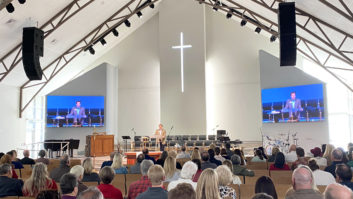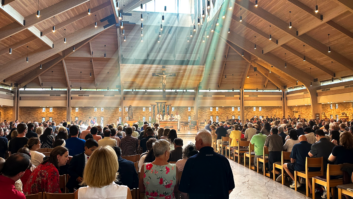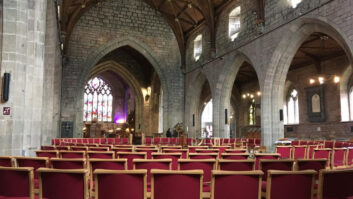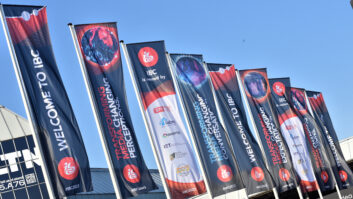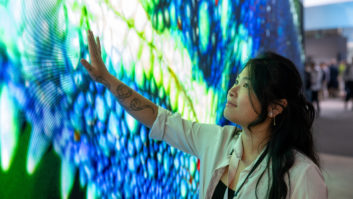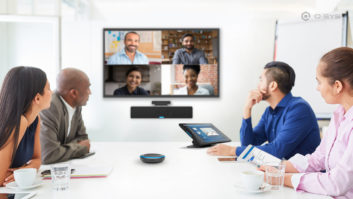In a dramatic turn of events that bears many comparisons with the corporate and education markets, houses of worship (HoW) had to switch from in-person to remote attendance – sometimes literally overnight – as the pandemic arrived in early 2020. Where the AV focus might hitherto have been overwhelmingly on the audio and video inside the church, worship leaders and their staff suddenly had to get to grips with the online world and make sure they had the means to reach their congregants in lockdown.
For the first section of this look at this exploration of the houses of worship (HoW) market, we will focus on video, where expectations have also been rising lately in accordance with the evolving needs of HoW congregations. Later in the feature, we’ll confirm that the willingness to invest in high-specification audio systems – often comparable to those in lauded concert venues and theatres – is increasingly commonplace.
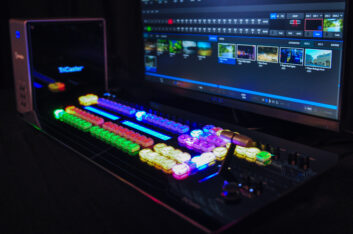 Few people would contest the assertion that the pandemic was a major impetus to upgrade; all of a sudden, church leaders were faced with a crisis that made in-person attendance essentially impossible. Therefore, acquiring the means to capture and stream worship events in high-quality became top priority – and for many churches, especially outside of the mega-HoW market of the US, this required them to enter an entirely new area of AV.
Few people would contest the assertion that the pandemic was a major impetus to upgrade; all of a sudden, church leaders were faced with a crisis that made in-person attendance essentially impossible. Therefore, acquiring the means to capture and stream worship events in high-quality became top priority – and for many churches, especially outside of the mega-HoW market of the US, this required them to enter an entirely new area of AV.
But whilst that initial reason for change has now faded, it’s clear that HoWs are not keen to relinquish the benefits of being able to reach remote congregants – not least as it gives them a greater in-built flexibility to adjust to demographic and societal changes. In addition, this infrastructure is also being used to generate and deliver other types of content away from regular worship events. All of which means that this market continues to be a rewarding one for AV vendors and service providers as 2024 dawns.
RELIABLE CONSISTENCY
Craig Heffernan, technical sales director EMEA at Blackmagic Design, provides a neat summary of the market’s recent trajectory: “Certainly, during the years of the pandemic, it became evident that our customers in HoW needed advice and guidance on how they could improve and upgrade their live production technologies to quickly move services and events online for live streaming and webcasting; [thereby] ensuring that they provided a constant and reliable support for their communities. We found many adapted whatever video equipment they had into streaming solutions, and often, our products like the ATEM Mini [production switcher] range and Web Presenter [streaming solution], provided that vital link into streaming and social media platforms quickly and effectively.”
Post-pandemic, that ability to support communities “beyond their venues” remains highly prized. It has, says Heffernan, “massive value – especially to those who cannot physically attend, may still be reliable, or are simply too far away. Consequently, there’s a growing demand to enhance earlier makeshift arrangements, with a keen interest in elevating the quality and quantity of online and webcast content.”
 Examples of technology enhancements cited by Heffernan include a move towards more advanced studio-level cameras, replacing older webcams and camcorders; and the supplanting of smaller production systems with “larger, full-scale ATEM switchers with greater effects and graphical capability. This is complemented by improvements to audio and lighting, as well as overall production design.” (A live streaming-oriented project for a church in Dallas, and covered by Installation here, is a case in point.)
Examples of technology enhancements cited by Heffernan include a move towards more advanced studio-level cameras, replacing older webcams and camcorders; and the supplanting of smaller production systems with “larger, full-scale ATEM switchers with greater effects and graphical capability. This is complemented by improvements to audio and lighting, as well as overall production design.” (A live streaming-oriented project for a church in Dallas, and covered by Installation here, is a case in point.)
MULTIFACETED FOCUS
It is likely that this multifaceted focus on AV infrastructure enhancement will continue for some time yet, coupled with the perennial desire for easy-to-use systems that can be operated by personnel who may not necessarily have a technical background.
Heffernan explains: “Enhancing video quality, streamlining production management and enriching the viewing experience have emerged as crucial points in recent discussions with our HoW customers. It’s evident that they aspire to deliver content that’s as clear for their in-person congregations as it is for their online audience, so it is crucial that the quality of their streaming or social media content is of paramount importance as high production values and delivers an engaging viewing experience.
“In addition, we recognise the need for user-friendly systems, understanding that many HoW customers are not experts in AV or video. Live production and webcasting technologies can be intimidating, which is why we prioritise intuitive, fast to learn, and scalable solutions.”
SHEER FLEXIBILITY
Scalability and flexibility are also familiar terms for Vizrt; its content production, management and distribution tools have long been a popular choice for worship venues. Justin Miller, pre-sales consultant at the company, reiterates the point about the pandemic having had an impact on demand: “HoW customers were forced to adapt to the circumstances, so we saw an increased interest in delivering their services to a remote congregation. But from our end, there wasn’t [an impact on related R&D] as we already had the necessary solutions to make that transition possible.”
Underlining his assertion that “the needs are always different [and] the right AV set-up will depend on the size of [HoW] and what they want to achieve”, Miller reveals that an extensive selection of Vizrt video production systems are now finding their way into worship facilities: “We’ve seen many TriCaster 1 Pros and TriCaster Minis getting installed in HoW facilities, which reflects the sheer flexibility of our solutions, as we’re talking about one of our high-end physical video switchers for large spaces all the way to our entry-level lineup for smaller organisations.”
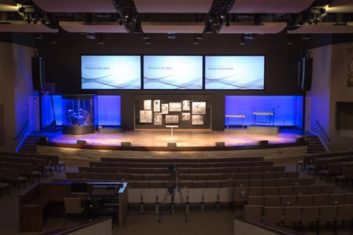 Two recently announced solutions – the TriCaster Mini Go physical switcher and cloud-based video switcher platform TriCaster Now – are also expected to resonate. Of the latter, Miller remarks that it “empowers anyone to connect, produce and stream content from anywhere – all under a convenient and always available on-demand model. This will be of particular interest to HoW clients, as there’re no large upfront costs, no physical hardware, and users always use the latest and greatest version of the product.”
Two recently announced solutions – the TriCaster Mini Go physical switcher and cloud-based video switcher platform TriCaster Now – are also expected to resonate. Of the latter, Miller remarks that it “empowers anyone to connect, produce and stream content from anywhere – all under a convenient and always available on-demand model. This will be of particular interest to HoW clients, as there’re no large upfront costs, no physical hardware, and users always use the latest and greatest version of the product.”
Aside from specific solutions, he pinpoints the management and sustainability of remote connections as being an enduring priority in the worship sector – something that Vizrt has addressed with use of the NDI networking technology originally developed by NewTek (the company which became part of Vizrt in 2019). “Innovating a reliable method for remote signal acquisition is one example of how it’s being done, with NDI Bridge connecting two or more AV networks across public internet for bi-directional contribution and remote administration,” he says.
Remarking that growth “across the APAC” region – as well as in the US – has been significant in recent years, Miller suggests that further improvements in video production and streaming capacity will remain the top tech priority for many worship venues. “Simplifying the remote participation and engagement for the HoW community that counts on live streaming will continue to be a focus for providers,” he remarks. “This spans from live testimony of remote participants being shared on-prem and to other remote guests simultaneously, all the way up to more live interaction options for remote participants.”
PAPAL APPROVAL
Arguably taking a dual-focus on image quality and streamlined production to its highest possible platform is a recent project for Sony, which continued its long-standing partnership with Vatican Media – the official institution within the Vatican responsible for broadcasting the Pope and the Vatican’s activity – by upgrading its broadcast system.
Invited to provide a package delivering the best quality footage with the smallest possible impact on the historic surroundings, Sony supplied multiple Sony HDC-5500 cameras – all connected (via Sony HDCE-100 adaptors) to a fibre network designed by the engineering department of the Vatican’s Dicastery for Communication and linking the cameras to the production control rooms – that can shoot in 4K, HD and HDR, along with Sony PVM-X series monitors situated in the production suite. Rounding out the new inventory, Sony also provided BRC-H800 PTZ cameras, and an FX9 camera to film St. Peter’s Square on a 24/7 basis.
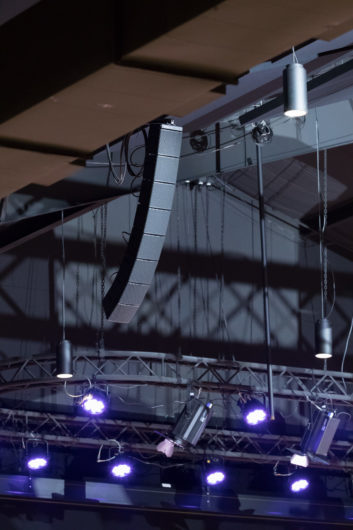 Norbert Paquet, head of live production solutions at Sony Professional Europe, says: “Our long-standing partnership with Vatican Media has enabled us to offer a scalable and reliable system that meets the need for shooting, producing and broadcasting around the world with a low impact on historical environments.”
Norbert Paquet, head of live production solutions at Sony Professional Europe, says: “Our long-standing partnership with Vatican Media has enabled us to offer a scalable and reliable system that meets the need for shooting, producing and broadcasting around the world with a low impact on historical environments.”
While relatively few HoWs are likely to possess the scale or requirements of the Vatican, this landmark project shows that even the most historic worship sites want to make the most of the latest AV and broadcast tech. And in an unpredictable world, where geopolitics and climate change are set to throw up even more barriers to in-person attendance, investing in solutions that maintain a high-quality connection with congregations – whatever the circumstances or location – is likely to become even more important.
AUDIO FOCUS
In a dramatic turn of events that bears many comparisons with the corporate and education markets, houses of worship (HoW) had to switch from in-person to remote attendance – sometimes literally overnight – as the pandemic arrived in early 2020. Where the AV focus might hitherto have been overwhelmingly on the audio and video inside the church, worship leaders and their staff suddenly had to get to grips with the online world and make sure they had the means to reach their congregants in lockdown.
As we saw earlier in this feature, these circumstances led – not unsurprisingly – to a year or two’s emphasis on improving video capture and streaming capabilities. But while many HoWs are continuing to stream their services to optimise their reach, the easing of pandemic conditions has inevitably meant something of a return to investment in on-site audio, lighting and display systems – making 2023, by general agreement, an extremely strong year for the worship market.
Nathan Ihlenfeldt is technical director – houses of worship, installation at Stage Audio Works, the South Africa-based technology solutions supplier, manufacturer and distributor. “Churches were delivering services remotely even before the pandemic, but they definitely made more effort during the pandemic as it was the only way to remain engaged with their congregations,” he says. “However, today the focus has shifted back to in-person gatherings that are supported by remote production, but it’s not the primary driver. There hasn’t been much talk about dedicated streaming solutions in a while.”
James Bobel – sales manager North America at next-generation immersive audio company HOLOPLOT – is not alone in drawing a parallel with another key market. “Similar to the phenomenon in the live entertainment sector, I think the pandemic has highlighted that people like to come together and share in their experiences,” he says. “We look for connection and in a worship environment it’s crucial to feel connected to the word and to each other. If you can’t follow what’s going on at the front it’s hard to do that, so intelligible audio is a crucial factor. Most people now have access to incredible high quality TVs and speakers at home, so live experiences have to match to this. In addition, we’re seeing a trend in churches being used as multi-purpose spaces. Whether this is a doubling up as a live music venue or conference space, a quality PA set-up is key.”
CONSISTENT COVERAGE
Therefore, it is not surprising that an adherence to addressing enduring reinforcement requirements – which can often be challenging in HoWs due to the age of the buildings and/or problematic acoustics – coupled with a desire to subtly refine their solutions is discernible in most audio providers’ responses to this market. Renkus-Heinz – whose latest innovations with resonance to HoWs include the OmniBeam beam-steering technology – is no exception.
Karl Brunvoll, the company’s vice-president of international sales, remarks: “The goal for any [HoW] sound system is consistent front-to-back audio coverage. Beam-steering technology allows loudspeakers to tightly control the sound and place it where needed – on the congregation – while keeping it away from other surfaces that may cause echoes and reverberation. The high directivity of our beam-steering arrays ensures intelligible speech and natural music reproduction for an engaging worship service.”
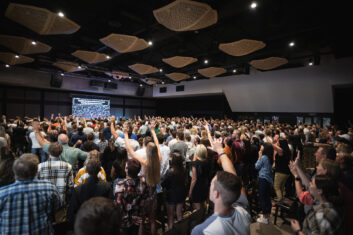 Moreover, Renkus-Heinz is “always listening to customer feedback as an input into our development roadmap” – a process that recently led to the development of the UBX Series of passive column arrays, which are designed to bring the acoustic and aesthetic benefits of steered sound into the passive realm.
Moreover, Renkus-Heinz is “always listening to customer feedback as an input into our development roadmap” – a process that recently led to the development of the UBX Series of passive column arrays, which are designed to bring the acoustic and aesthetic benefits of steered sound into the passive realm.
“The high directivity of our UBX Series is the perfect solution for the highly reverberant spaces found in many [HoWs],” remarks Brunvoll. “By steering sound away from walls and ceilings to focus directly on the congregation, our Passive UniBeam Technology delivers clear, consistent audio for the whole community. Unlike traditional passive columns, UBX Series loudspeakers often don’t need to be physically aimed or tilted to ensure ideal coverage; with pre-steered beams, the UBX Series can be mounted plumb to the wall, reducing architectural intrusion and ensuring clear sightlines for worshippers.”
AVOIDANCE ZONES
Whilst Renkus-Heinz is a long-established presence in HoWs, then HOLOPLOT is, by its own admission, a relative newcomer. But that doesn’t mean the Berlin-based manufacturer hasn’t already had the opportunity to weigh up the opportunities for its 3D Audio-Beamforming technology in what are frequently highly reverberant spaces with inherent challenges for intelligibility.
“Houses of worship are often extremely reverberant spaces,” notes Bobel, “[but] our technology allows you to create avoidance zones that keep energy away from hard surfaces, focusing the energy where it’s needed – creating cleaner, more intelligible audio and reducing the need for acoustic treatment.”
By way of example, Bobel points to a 2022 installation of a HOLOPLOT X1 matrix array sound system at Masjid Misr, a 10,000 sqm mosque in Egypt (previously covered by Installation online here). “A conventional sound system would’ve required upwards of 30 positions to achieve sufficient coverage and intelligibility within such a space,” he says.
“HOLOPLOT technology delivered unmatched levels of coverage and intelligibility with only nine array positions and was completely concealed, in some positions mounted at extreme heights of up to 23m above the floor, rendering it ultimately invisible to worshippers.”
AUDIO INCLUSIVITY
After a period in which remote worship was de rigeur, there are also indications that HoWs are looking to boost their inclusivity of all congregants, including those who have hearing problems or could benefit from translation services. Once again, it’s an area in which vendors are continuing to innovate, with a series of new solutions either reaching the market or being announced for launch in recent months.
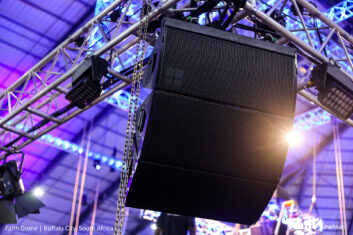 For HOLOPLOT, Bobel highlights its ability to enable translation services. “One of our unique offerings is that we can create listening zones with differing content, all from the same sound system,” he says. “This year, we delivered the first-ever simultaneous translation project and I see the benefits of this same approach for [HoWs]. Offering services in multiple languages can help make churches more inclusive and forge connections among the congregation.” The company has also just launched a more compact version of the X1, entitled X2, “created specifically for speech applications”.
For HOLOPLOT, Bobel highlights its ability to enable translation services. “One of our unique offerings is that we can create listening zones with differing content, all from the same sound system,” he says. “This year, we delivered the first-ever simultaneous translation project and I see the benefits of this same approach for [HoWs]. Offering services in multiple languages can help make churches more inclusive and forge connections among the congregation.” The company has also just launched a more compact version of the X1, entitled X2, “created specifically for speech applications”.
Inclusivity is at the core of Listen Technologies’ presence in the market, where its assistive listening systems include solutions for WiFi, RFinfrared and two-way communication. Referring to the company’s home market of the US, Listen Technologies regional sales manager Brian Reilly observes that assistive listening in HoWs is not required by the Americans With Disabilities Act (although in some states, such as California and Texas, it is stipulated by separate building regulations), meaning that HoW staff are often providing this capacity “out of the goodness of their hearts and to give a good experience because they care about the people that are coming into their spaces.”
It’s also important to address what Reilly implies is a lingering misunderstanding of HoW audio in some quarters. “You can have all these wonderful audio systems [in a church], and some might say that the people coming in with hearing deficiencies have hearing aids, so isn’t that good enough for them? But in reality, the distance for good, clear communication and pickup for somebody with a hearing aid [to experience intelligibility] is about three to six feet. Anything beyond that, it’s going to be louder, noisier, more confusing and not a good experience. And what happens then is that congregants might leave, which also means that any kind of contributions they might make to this particular HoW leaves with them.”
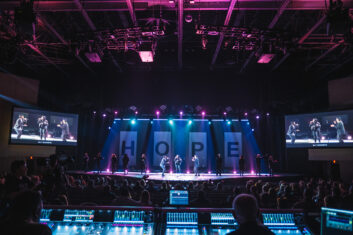 So it’s no wonder that “facilities are taking a look at their technology because things have gone remote in the last couple of years and now it’s starting to come back.” Among the solutions that are most in-demand are Listen EVERYWHERE, the audio-over-WiFi solution that allows venues to stream audio over their wireless network to guests’ smartphones. Guests access the audio via an app and listen with their headphones or earbuds. (A new generation of Listen EVERYWHERE, to be called ListenWIFI, was announced at InfoComm 2023 and is expected to begin shipping in early 2024.)
So it’s no wonder that “facilities are taking a look at their technology because things have gone remote in the last couple of years and now it’s starting to come back.” Among the solutions that are most in-demand are Listen EVERYWHERE, the audio-over-WiFi solution that allows venues to stream audio over their wireless network to guests’ smartphones. Guests access the audio via an app and listen with their headphones or earbuds. (A new generation of Listen EVERYWHERE, to be called ListenWIFI, was announced at InfoComm 2023 and is expected to begin shipping in early 2024.)
The system includes new receivers, beacons and servers, while the end-user app reflects a desire to accommodate the expectations of younger congregants. “With the advent of our ListenWIFI product, more specifically, beacons, the venue can design the Wi-Fi system to automatically trigger content when an end user enters a predetermined zone, providing a truly seamless experience. We have digital natives now coming up and so we want to make sure that their experience is similar to what they’re having in schools and at home.”
Meanwhile, from an installation point of view, an increasing number of venues are opting for Dante networking that facilitates remote management. “We haven’t abandoned the analogue route and we still offer that,” clarifies Reilly, “but there is a demand to manage [assistive listening systems] on your IT network, and having a Dante-enabled device allows for that and gives you the ability to manage things remotely, too.”
DE FACTO STANDARD
Rising demand for wireless and IP-oriented systems is also discernible in HoW’s utilisation of intercom systems, notes Clear-Com president Bob Boster: “We have seen an increased uptake on wireless and IP-based intercom use in the HoW market over the last few years as services have become much more reliant on people contributing remotely and live streaming. Wireless intercom systems have become the de facto standard, as more people want to be untethered from a single area.”
There is also a growing market for unified management solutions, including for churches that operate across multiple physical sites. To this end, Clear-Com’s Arcadia Central Station, introduced in 2021, “has been incredibly popular with the HoW market as it integrates multiple systems in a compact and easy-to-use package that can grow with a church’s needs through licensed ports, making it a solid investment centrepiece to an intercom system.”
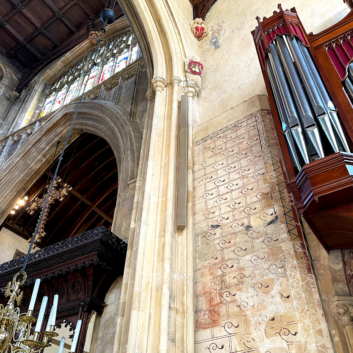 Arcadia supports Clear-Com’s FreeSpeak digital wireless system, the HelixNet digital partyline for wired endpoints and – with the latest update – connects to the LQ Series of IP interfaces. “This brings in the option to incorporate Clear-Com’s Agent-IC mobile app (very popular as a BYOD option), Station-IC virtual desktop client, and two-way radio interfacing,” says Boster. “LQ is also a popular tool for linking together multiple church campuses, so many of the HoW users already have one in their toolkit.”
Arcadia supports Clear-Com’s FreeSpeak digital wireless system, the HelixNet digital partyline for wired endpoints and – with the latest update – connects to the LQ Series of IP interfaces. “This brings in the option to incorporate Clear-Com’s Agent-IC mobile app (very popular as a BYOD option), Station-IC virtual desktop client, and two-way radio interfacing,” says Boster. “LQ is also a popular tool for linking together multiple church campuses, so many of the HoW users already have one in their toolkit.”
ONGOING EMPHASIS
Invited to consider the outlook for HoW AV over the next few years, our contributors evince a consensus view that churches will continue to invest in new systems to improve the experience for all congregants – regardless of location or personal requirements – while there will also be an ongoing emphasis on making system usage and management as fuss-free as possible.
“Worshippers – and church leaders – expect AV production quality that is similar to secular events,” says Ihlenfeldt. “There is an emphasis on better management and easier to use systems to try and reduce reliance on volunteers, who are often unskilled in this part of the world. There has been no specific influence on our projects except that people are perhaps making more informed choices.”
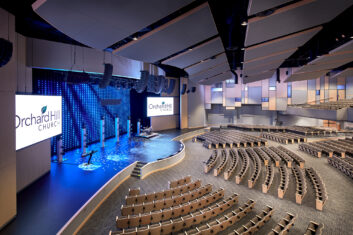 Bobel expects a continued heightened expectation around new systems being both sonically and aesthetically satisfying. “I’d say everyone is paying more attention to how things look as well as sound,” he says. “[So with HOLOPLOT] our loudspeakers can be moved behind an LED wall or above the sightlines for the video crew – an important element when delivering live content for streaming.
Bobel expects a continued heightened expectation around new systems being both sonically and aesthetically satisfying. “I’d say everyone is paying more attention to how things look as well as sound,” he says. “[So with HOLOPLOT] our loudspeakers can be moved behind an LED wall or above the sightlines for the video crew – an important element when delivering live content for streaming.
Finally, Brunvoll envisages an ongoing, across-the-board emphasis on improving quality. “We see a trend that traditional places of worship like cathedrals, churches, mosques and temples need to improve the quality of the existing sound systems to meet the expectations of their worshippers,” he says. “Our experience is that congregations worldwide are allocating funds for better, more suitable technology, with extraordinarily positive results. This trend will continue, and we are determined to be present with sound solutions that make a difference.”
